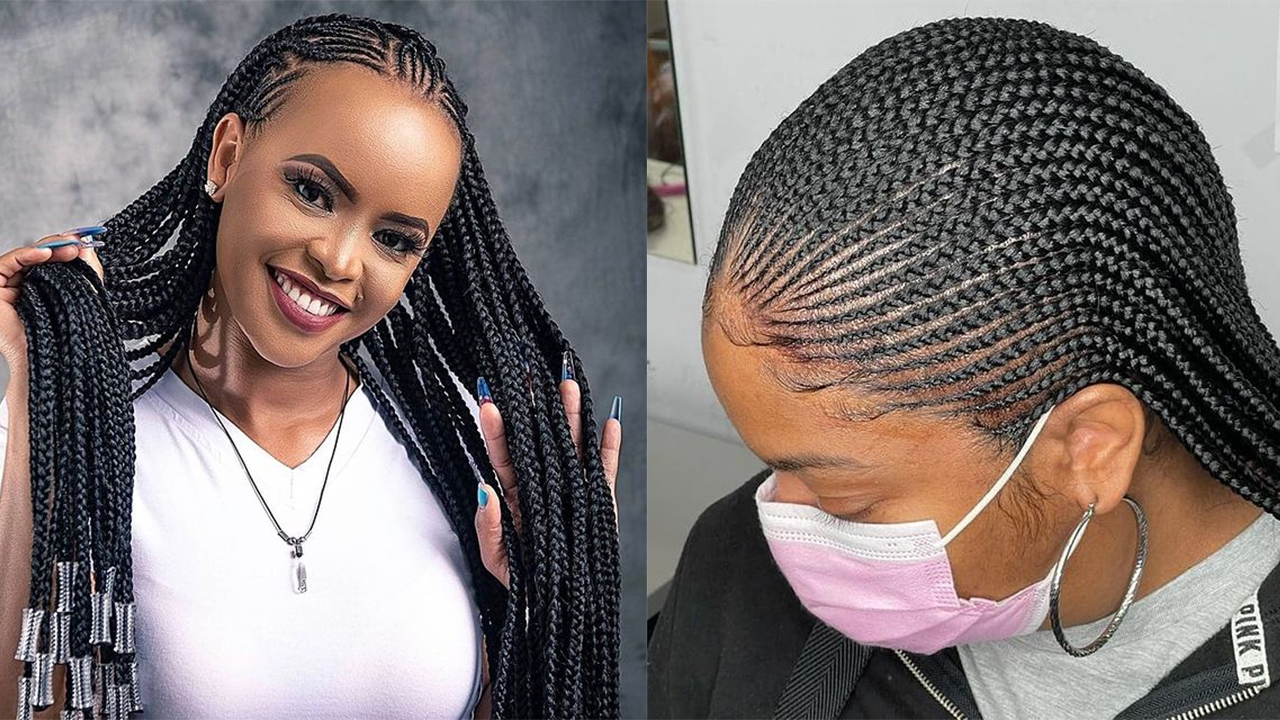Ghanaian braids, alternatively referred to as feed-in braids, involve a gradual incorporation of extensions to achieve a smooth and authentic braid appearance. In contrast, knotless braids utilize a distinctive method that gradually incorporates extensions without forming a knot or protrusion at the base of the braid. This technique produces a hairstyle that appears more natural and comfortable, reducing scalp tension.
Protective Hairstyles for short Braids
What are African Braids
African braids refer to a broad category of braided hairstyles that have their roots in various African cultures and traditions. These hairstyles are characterized by intricate braiding techniques, creative patterns, and the use of extensions to achieve versatile and stylish looks.
African braids encompass a wide range of styles, including but not limited to:
- Box Braids: These are small to medium-sized braids that are sectioned into square or rectangular shapes.
- Cornrows: These are closely braided rows of hair that are flat against the scalp. Cornrows can be styled in various patterns and designs.
- Senegalese Twists: These are two-strand twists that are created using extensions and are often larger in size compared to other braids.
- Fulani Braids: Inspired by the Fulani people of West Africa, these braids usually involve a central braid or parting with decorative elements such as beads or cowrie shells.
- Micro Braids: These are very tiny braids that are braided close to the scalp, creating a delicate and intricate look.
- Goddess Braids: These are larger braids that are often styled in an updo or halo-like pattern, providing a regal and goddess-like appearance.
- Havana Twists: Similar to Senegalese twists, Havana twists are larger and have a more textured and chunky appearance.
What are Ghanaian Braids?
Ghanaian braids, originating from West Africa, particularly Ghana, are a type of protective hairstyle. This intricate style involves skillfully weaving small to medium-sized cornrows into symmetrical or circular patterns. The braids are meticulously created by tightly braiding sections of hair underhand, resulting in a close-to-the-scalp appearance. These braids can be styled in various ways, such as twists, pins, or wraps, and can be either long or short.
Ghana braids are typically created by adding extensions gradually as the braids progress, resulting in a seamless and natural-looking hairstyle. This technique is often referred to as “feed-in” because the extensions are fed into the braid as it is being created.
Ghana braids have gained significant popularity among women of African descent worldwide. They offer a customizable option to match individual style preferences and serve as a fashionable and practical alternative to other hairstyles. Not only are Ghanaian braids aesthetically pleasing and versatile, but they also hold cultural and fashion significance within African communities. Embracing Ghanaian braids can be a way to celebrate heritage and take pride in African hairstyles, making them accessible to anyone who appreciates their beauty and symbolism.
What are Knotless Braids?
Knotless braids have gained popularity as a trendy and protective hairstyle, offering a contemporary twist on Natural braids. Unlike conventional box braids, knotless braids feature a seamless and organic appearance without any knots or bumps at the base of each braid. The technique involves starting each braid with a small section of natural hair and gradually incorporating additional hair in small increments as the braid progresses.
One of the notable advantages of knotless braids is their reduced potential for tension and discomfort at the scalp. Without knots or bumps, these braids exert less pull on the hair, minimizing the risk of pain and hair loss over time. Knotless braids also offer versatility in styling, as they can be worn in a simple ponytail, various braided styles, or elaborate updos. Additionally, they require minimal maintenance and can last several weeks with proper care.
Knotless braids serve as both a beautiful and functional alternative to traditional braids, providing a protective hairstyle that is chic and easy to wear. They help safeguard the hair from damage and breakage while enhancing one’s overall appearance and staying on-trend.
>>Read More: Move to Canada with Express Entry Sponsorship Programs – Free Guide 2023
Difference Between Ghanaian Braids and Knotless Braids
Ghanaian braids, also known as feed-in braids, and knotless braids are both popular protective hairstyles that involve braiding natural hair with extensions. However, there are distinct differences between the two styles. Ghanaian braids employ a technique where extensions are gradually added in small sections to create a seamless and natural-looking braid. These braids can be styled in various ways, such as cornrows, box braids, or twists, starting at the scalp.
On the other hand, knotless braids utilize a unique technique where extensions are gradually incorporated into the natural hair without creating knots or bulges at the base of the braids. This results in a hairstyle that appears more natural and comfortable, with reduced tension on the scalp and a lower risk of hair breakage. The main distinctions between Ghanaian braids and knotless braids lie in the extension addition method and the overall look and feel of the hairstyle. Ghanaian braids involve a feed-in approach, while knotless braids employ a specialized knotless method.







